
The Scoliidae, the scoliid wasps, are a family of wasps comprising about 560 species worldwide. They tend to be black, often marked with yellow or orange, and their wing tips are distinctively corrugated. Males are more slender and elongated than females, with significantly longer antennae, but the sexual dimorphism is not as apparent as in many of the Tiphiidae and Thynnidae.

Cymothoa exigua, or the tongue-eating louse, is a parasitic isopod of the family Cymothoidae. It enters fish through the gills. The female attaches to the tongue, while the male attaches to the gill arches beneath and behind the female. Females are 8–29 mm (0.3–1.1 in) long and 4–14 mm (0.16–0.55 in) wide. Males are about 7.5–15 mm (0.3–0.6 in) long and 3–7 mm (0.12–0.28 in) wide. The parasite severs the blood vessels in the fish's tongue, causing the tongue to fall off. It then attaches itself to the remaining stub of tongue and the parasite itself effectively serves as the fish's new "tongue".

Ponometia is a genus of moths of the family Noctuidae. The genus was erected by Gottlieb August Wilhelm Herrich-Schäffer in 1868.
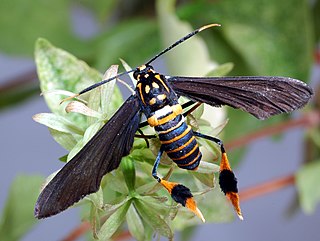
Horama panthalon, the Texas wasp moth, is a moth of the subfamily Arctiinae. The species was first described by Johan Christian Fabricius in 1793. It is found in South America, Central America, Mexico, the Antilles and southern United States.

Ponometia semiflava, the half-yellow or yellow-cloaked midget, is a moth of the family Noctuidae. The species was first described by Achille Guenée in 1852. It is found in North America from New York and New England to Florida, west to Arizona, north to British Columbia and Manitoba.
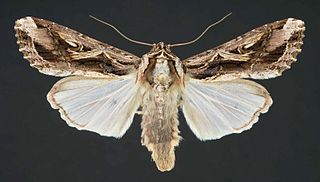
Spodoptera dolichos, the dolichos armyworm moth or sweetpotato armyworm moth, is a moth of the family Noctuidae. The species was first described by Johan Christian Fabricius in 1794. It is found from the southern United States, south through Costa Rica to South America, as far south as Argentina. In the United States, it may occur as far north as Kentucky and Maryland.

Hemiargus ceraunus, the Ceraunus blue, is a species of butterfly in the family Lycaenidae. The species was first described by Johan Christian Fabricius in 1793. It is found in the southwestern United States, southern Texas, Florida and the Florida Keys south through the West Indies, Mexico and Central America to South America. Strays may be found in North Carolina, Missouri, Kansas and Nevada. The habitat consists of open woodland, desert scrub, dunes, pastures, road edges and vacant lots.
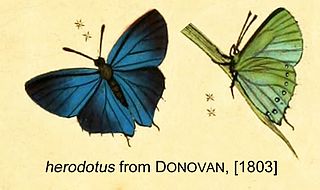
Cyanophrys herodotus, the tropical green hairstreak or tropical greenstreak, is a butterfly of the family Lycaenidae. It was described by Johan Christian Fabricius in 1793. It is found in Mexico, Guatemala, Panama, Nicaragua, Colombia, Ecuador, Peru, Bolivia, Brazil, Paraguay and Argentina. Rare strays can be found as far north as southern Texas. The habitat consists of open disturbed areas in tropical and subtropical rainforests and cloudforests at altitudes ranging from 600 to about 2,000 meters.

Ponometia candefacta, the olive-shaded bird-dropping moth, is a moth of the family Noctuidae. It is found in North America, where it has been recorded from the northern United States to southern Mexico. It has been introduced to Russia as a biological control agent of Ambrosia artemisiifolia. The habitat consists of dry, weedy, disturbed areas at low elevations.

Ponometia erastrioides, the small bird-dropping moth or small bird lime moth, is a moth of the family Noctuidae. It is found in North America, where it has been recorded from the eastern United States and south-central Canada. The habitat consists of fields, waste places and riparian areas.
Ponometia virginalis is a species of bird dropping moth in the family Noctuidae. It is found in North America, where it has been recorded from eastern Texas to Nebraska, west to eastern Arizona in the south, and to Utah, Colorado, and Wyoming in the west.
Ponometia sutrix is a species of bird dropping moth in the family Noctuidae. It is found in North America.
Ponometia tripartita is a species of bird dropping moth in the family Noctuidae. It is found in North America.
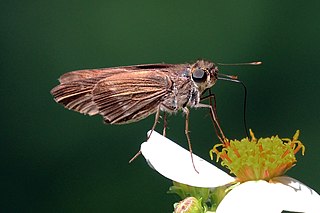
Panoquina lucas, the purple-washed skipper, is a species of grass skipper in the butterfly family Hesperiidae. It is found in the Caribbean Sea, Central America, North America, and South America.
Ponometia nigra is a species of bird dropping moth in the family Noctuidae. It is found in North America.
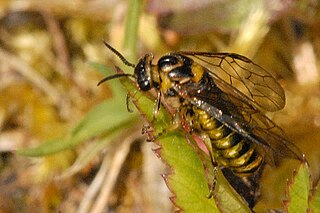
Gilpinia is a genus of sawflies belonging to the family Diprionidae.










